Graft - a method by which it is possible to propagate, renew, restore plants, as well as obtain the necessary properties from them. Additionally, it allows you to display more resistant to the effects of negative factors varieties, improve their taste and more. As a rule, such an event is held in autumn, but summer and winter grafting of grapes is not excluded.
Content
Why plant grapes
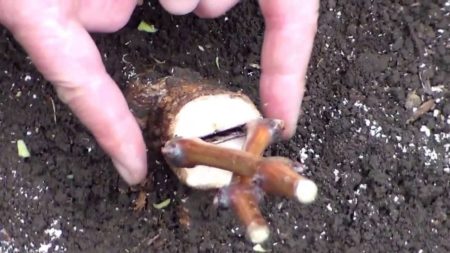
Since grape tinting is a set of actions during which a fragment of one plant species moves and takes root on the shoot of another, it leads to an improvement in the taste, appearance and other qualities of grapes. Also, using it you can solve the following issues:
- The transfer of the characteristics of well-bearing and growing vine bushes to other representatives.
- Improving the taste of fruits by planting more sweet and juicy varieties.
- Increased immunity, resistance to weather conditions and pests.
- Save space in the garden.
- Checking the stability of a new variety acquired.
- Replacing an existing grape variety with a more profitable one.
Vaccination of grapes in autumn: timing of vaccination
The most suitable time for vaccination in the autumn is October. This month the weather is fairly warm and the soil has not cooled yet. For tinting, the temperature indices of the soil should not fall below 10 ° C.
Benefits of Autumn Grape Vaccination
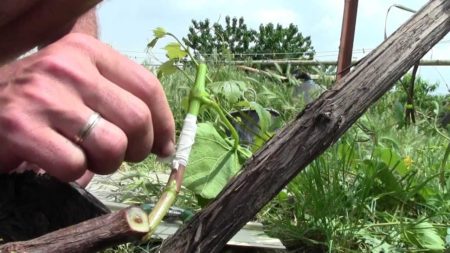
Vaccination of grapes in autumn has a number of advantages compared to summer and winter tinting:
- The grafted vine begins to produce crops already next season.
- Vaccination has a positive effect on the number of berries in clusters, their size and the productivity of the plant as a whole.
- Certain species may begin to mature in a shorter time.
- A high probability that a rare and moody variety will be able to take root successfully.
The most common reasons for grafting grapes in autumn:
- A small crop of the old bush. Transferring fragments of a young plant to an old bush allows you to restore its productivity.
- Unstable to weather conditions and not suitable for fruiting variety. Tinting allows you to transfer characteristics of another species to such a plant. As a result, adapted, dense and developed roots and shrubs with suitable fruiting characteristics are combined.
Scion preparation
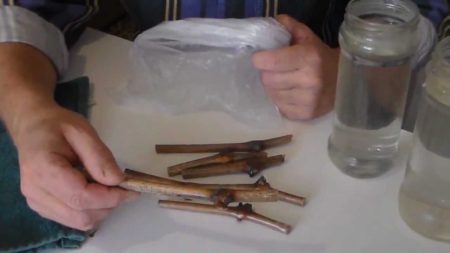
We prepare grafting cuttings only when the “source” falls under the following characteristics:
- the vine has ripened, and its bark has acquired a yellow-brown color, and has also become dry and hard;
- harvested from the vine at least once.
And the cuttings themselves meet the following requirements:
- size - 60 cm;
- width - 7-14 mm;
- only kidneys are on the surface, the rest is removed.
First, we scrub the scion in a heteroauxin solution, which effectively stimulates plant growth by activating cell division.
Add paraffin to a container of water, and then heat to a boil, melting it. Water will not dissolve the substance, but due to its high temperature it will be in its liquid state on its surface.
Next, quickly dip the cuttings into it, and then lower it into the water.We do this so that they are not damaged by temperature. The cuttings must be dry so that the moisture released by the plant does not repel paraffin and does not lower the quality of its processing.
Then we spend pruning cuttings. We make it at an angle where the grafting will take place, at a distance of 1.5 cm from the first kidney. Immerse the scion in water until inoculation.
How to plant grapes in autumn
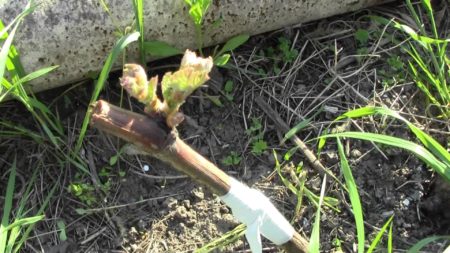
All tools used in the grafting process must be clean and treated with alcohol. We prepare a scion a week before vaccination. The tinting itself is carried out as follows:
- We clean the upper root part of the grape, on which we will inoculate the stalk.
- Carefully cut off the ground part of the bush, making a cut at a height of about 12 cm from the ground. There should not be any irregularities, traces of any diseases or pests on the cut. If necessary, gently grind and grind to avoid the development of pathogenic bacteria on bumps.
- The upper part of the remaining part of the bush (stamb) is cleared of the remnants of the bark and treated with 3% copper sulfate. A stamp is a round or oval fragment of a trunk that begins in the upper root part of the plant and ends with branching.
- We split with an ax, secateurs or a knife the place prepared for vaccination, in the center of the circle. We breed it with a screwdriver and a hammer so that the trunk structure is not disturbed from too strong breeding, and then we insert a pointed handle. The graft is deepened into the shaft so that the cut point is in full contact with the cleavage. All the formed cracks and voids are covered as much as possible with pieces of vine or fragments of damp toilet paper.
- We wrap the connection with a film or cotton fabric, fixing it.
- Loosen and water the earth around the bush.
- Sprinkle with new soil and cover with a film, not forgetting to make a hole for the bush itself.
For beginners, we have prepared a detailed video on how to vaccinate grapes.
Grape Care after Vaccination
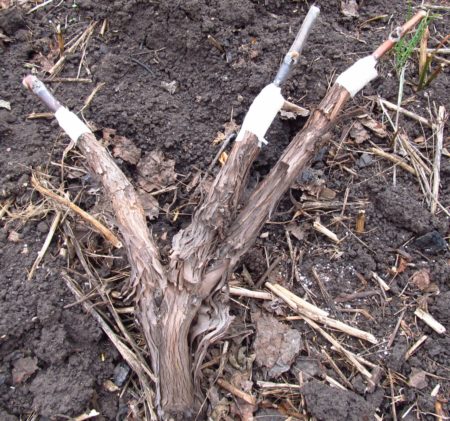
Plant care after vaccination consists of the following measures:
- Water regularly and spud the plant so that the soil is saturated with oxygen.
- If shoots did not form shoots 14 days after vaccination, re-grape the grapes, having previously cut the upper part of the stock and the place of grafting.
- We check the condition of the scion every 1.5 weeks, remove all the roots that it produces that are not included in the stock.
- If juice arising from the plant is found, weaken the winding of the vaccine.
- For the winter we warm the plant with a layer of hay or straw, as well as branches of spruce.
- We treat the plant with antifungal drugs.
Mistakes Newcomers Make
In order for the stalk to successfully take root, we try to avoid the following errors:
- Wrong scion storage. Cuttings must be processed with paraffin or stored in a bag. Otherwise, they will lose a large amount of moisture, dry out and not take root.
- Cleavage too deep. This can cause rot due to moisture.
- Rough and rough cut. It must be sanded, otherwise the stalk will not take root, and bacteria will form on the cut.
Useful Tips
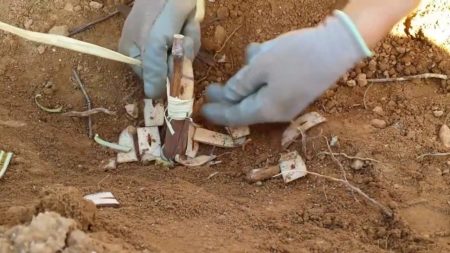
For the success of the grafting process, we recommend that you consider the following points:
- The cutle should not be too long, just two buds on its surface are enough.
- Before planting a plant, we fertilize the soil around the bush.
- If the stock is thick enough, then you can try to plant several cuttings. This will increase the chances of success.
Vaccination of grapes in the autumn is an excellent opportunity to improve its variety, as well as renew the old plant.To graft grapes correctly, follow the basic rules for successful grafting and our recommendations for this procedure.

 Non-covering winter-hardy grape varieties for Moscow region
Non-covering winter-hardy grape varieties for Moscow region How to keep the vine in winter
How to keep the vine in winter When can I transfer grapes to another place in the fall
When can I transfer grapes to another place in the fall How to cover and prepare grapes for the winter in the suburbs
How to cover and prepare grapes for the winter in the suburbs